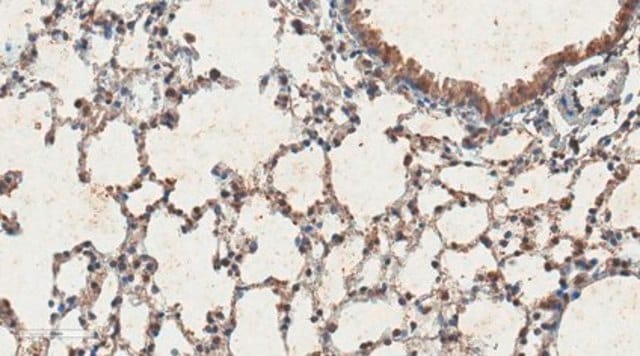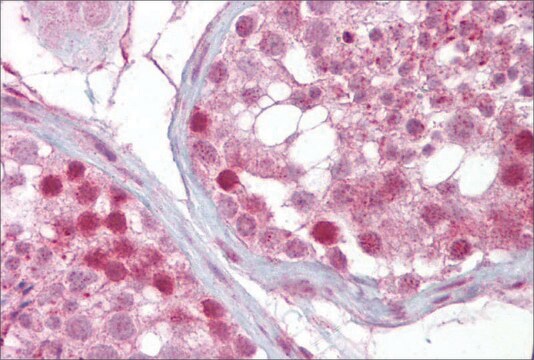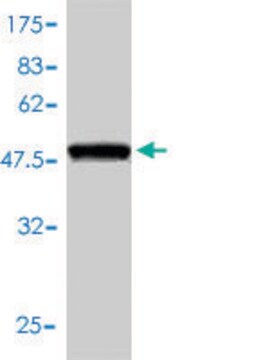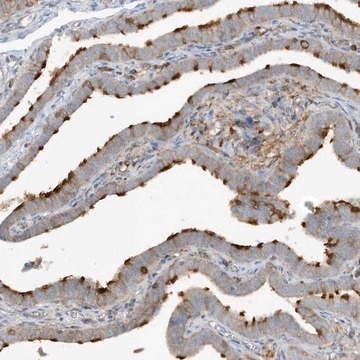ABC932
Anti-IFT88 Antibody
serum, from rabbit
Synonim(y):
Intraflagellar transport protein 88 homolog, Polaris, Recessive polycystic kidney disease protein Tg737, Tetratricopeptide repeat protein 10, TgN(Imorpk)737Rpw, TPR repeat protein 10
About This Item
Polecane produkty
pochodzenie biologiczne
rabbit
Poziom jakości
forma przeciwciała
serum
rodzaj przeciwciała
primary antibodies
klon
polyclonal
reaktywność gatunkowa
rat, human, mouse
reaktywność gatunkowa (przewidywana na podstawie homologii)
bovine (based on 100% sequence homology)
metody
electron microscopy: suitable
immunocytochemistry: suitable
immunofluorescence: suitable
western blot: suitable
numer dostępu NCBI
numer dostępu UniProt
Warunki transportu
dry ice
docelowa modyfikacja potranslacyjna
unmodified
informacje o genach
bovine ... Ift88(514177)
human ... IFT88(8100)
mouse ... Ift88(21821)
rat ... Ift88(305918)
Opis ogólny
Specyficzność
Immunogen
Zastosowanie
Western Blotting Analysis: A representative lot detected a greatly reduced Tg737/Polaris expression in lysate from E11.5 mouse embryo limbs with conditional mesenchymal Ift88-knockout (prx1cre;Ift88fl/n) when compared with lysate from a wild-type littermate (Haycraft, C.J., et al. (2007). Development. 134(2):307-316).
Immunocytochemistry Analysis: A representative lot detected IFT88 (Tg737/Polaris) cellular localization in paraformaldehyde-fixed rat and murine sperm cells, rat round spermatids, as well as elongating spermatids from Ift88 mutant mice (Kierszenbaum, A.L., et al. (2011). Dev. Dyn. 240(3):723-736).
Immunocytochemistry Analysis: A representative lot detected Tg737/Polaris immunoreactivity associated with the cilium of cultured limb bud cells isolated from wild-type mouse E11.5 embryos by fluorescent immunocytochemistry, while cilia were absent in cells from Tg737Δ2–3β-gal embryos (Haycraft, C.J., et al. (2005). PLoS Genet. 1(4):e53).
Electron Microscopy Analysis: A representative lot detected IFT88 (Tg737/Polaris) localization in rat round spermatids and fractionated manchettes (Kierszenbaum, A.L., et al. (2011). Dev. Dyn. 240(3):723-736).
Immunofluorescence Analysis: A representative lot detected polaris immunoreactivity in both dental epithelium (DE) and dental mesenchyme (DM) of lower molar frontal sections from E13.5 and E16.5 embryonic mice (Ohazama, A., et al. (2009). Development. 136(6):897-903).
Immunofluorescence Analysis: A representative lot immunostained primary cilium on epithelial and mesenchymal cells of the skin and hair follicle using OCT-embedded frozen skin sections from both mouse embryos and adult mice (Lehman, J.M., et al. (2009). J. Invest. Dermatol. 129(2):438-448).
Immunofluorescence Analysis: A representative lot detected Ift88 (Tg737/Polaris) immunoreactivity enriched at the base and tip of the hair cell (HC) kinocilia in the ciliary axonemes by fluorescent immunohistochemistry using 4% paraformaldehyde-fixed inner ear cochlear whole mounts prepared from mouse E14.5 embryos (Jones, C., et al. (2008). Nat. Genet. 40(1):69-77).
Immunofluorescence Analysis: A representative lot immunostained cilium in mesenchymal and ectodermal cells in formaldehye-fixed, OCT-embedded frozen limb bud sections from mouse E11.5 embryos by fluorescent immunohistochemistry. Conditional mesenchymal Ift88-knockout (prx1cre;Ift88fl/n) selectively abolished Tg737/Polaris immunoreactivity in the mesenchyme, but not the ectoderm layer (Haycraft, C.J., et al. (2007). Development. 134(2):307-316).
Immunofluorescence Analysis: A representative lot detected Tg737/Polaris immunoreactivity at the base and distal tip of cilium in mesenchymal and ectodermal cells in OCT-embedded frozen limb bud sections from mouse E10.5 embryos by fluorescent immunohistochemistry (Haycraft, C.J., et al. (2005). PLoS Genet. 1(4):e53).
Apoptosis & Cancer
Developmental Signaling
Jakość
Western Blotting Analysis: A 1:200 dilution of this antibody detected IFT88 in 50 µg of mouse kidney tissue lysate.
Opis wartości docelowych
Postać fizyczna
Przechowywanie i stabilność
Handling Recommendations: Upon receipt and prior to removing the cap, centrifuge the vial and gently mix the solution. Aliquot into microcentrifuge tubes and store at -20°C. Avoid repeated freeze/thaw cycles, which may damage IgG and affect product performance.
Inne uwagi
Oświadczenie o zrzeczeniu się odpowiedzialności
Not finding the right product?
Try our Narzędzie selektora produktów.
Kod klasy składowania
12 - Non Combustible Liquids
Klasa zagrożenia wodnego (WGK)
WGK 1
Temperatura zapłonu (°F)
Not applicable
Temperatura zapłonu (°C)
Not applicable
Certyfikaty analizy (CoA)
Poszukaj Certyfikaty analizy (CoA), wpisując numer partii/serii produktów. Numery serii i partii można znaleźć na etykiecie produktu po słowach „seria” lub „partia”.
Masz już ten produkt?
Dokumenty związane z niedawno zakupionymi produktami zostały zamieszczone w Bibliotece dokumentów.
Nasz zespół naukowców ma doświadczenie we wszystkich obszarach badań, w tym w naukach przyrodniczych, materiałoznawstwie, syntezie chemicznej, chromatografii, analityce i wielu innych dziedzinach.
Skontaktuj się z zespołem ds. pomocy technicznej








